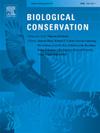在可再生能源项目中,巢箱供应作为一种抵消或洗绿的做法
IF 4.4
1区 环境科学与生态学
Q1 BIODIVERSITY CONSERVATION
引用次数: 0
摘要
可再生能源,特别是光伏电站(PV)的全球扩张旨在满足不断增长的能源需求,同时降低碳排放并应对气候变化。在西班牙,这些项目威胁着生物多样性,尤其是在草原环境中。西班牙法律鼓励能源公司实施生物多样性补偿,如巢箱安装,这是一项广泛应用的措施(高达85.6%的光伏电站)。本研究严格检查了光伏开发中巢箱安装的生态适应性,并评估了其在生物多样性保护方面的有效性。通过对西班牙光伏电站环境影响评估(eia)的全面审查,我们发现了其设计和实施中反复出现的缺陷,包括在目标物种不栖息的地区不适当地应用巢箱,巢箱放置不当,以及缺乏安装后监测。西班牙是欧盟生物多样性最丰富的国家,也是欧盟计划开展更多可再生能源项目的国家。此外,巢箱的使用经常绕过世界自然保护联盟的缓解等级制度,导致对环境责任的误解——被称为“洗绿”——同时未能解决光伏基础设施的真正生态后果。我们认为,需要一种更科学严谨的方法,包括遵守缓解等级制度,对使用巢箱的物种进行适应性评估,以及对其安装进行监管。建立国家协调咨询中心,规范光伏项目巢箱使用行为,确保有效监测,科学监管。这将有助于优化生物多样性保护工作,降低生态危害风险。本文章由计算机程序翻译,如有差异,请以英文原文为准。
Nest-box provisioning as an offset or greenwashing practice in renewables projects
The global expansion of renewable energy, particularly photovoltaic plants (PV), aims to meet rising energy demands while lowering carbon emissions and addressing climate change. In Spain, these projects threaten biodiversity, especially in steppe environments. Spanish law encourages energy companies to implement biodiversity offsets, such as nest-box installation, which is a vastly applied measure (in up to 85.6 % of photovoltaic plants). This study critically examines the ecological suitability of nest-box installation in PV developments and assesses its effectiveness in biodiversity conservation. Through a comprehensive review of Environmental Impact Assessments (EIAs) for PV plants across Spain, the most biodiverse country and one where more renewables projects are planned in the EU, we identify recurring flaws in their design and implementation, including the inappropriate application of nest-boxes in areas where target species do not reside, poor nest-box placement, and lack of post-installation monitoring. Furthermore, the use of nest-boxes often bypasses the IUCN mitigation hierarchy, contributing to misleading perceptions of environmental responsibility—known as greenwashing—while failing to address the true ecological consequences of PV infrastructure. We argue that a more scientifically rigorous approach is needed, including compliance with the mitigation hierarchy, fitness assessments for species using nest-boxes, and regulation of their installation. A national coordination and advisory center should be established to standardize practices, ensure effective monitoring, and provide scientific oversight of nest-box use in PV projects. This will help optimize biodiversity conservation efforts and reduce the risk of ecological harm.
求助全文
通过发布文献求助,成功后即可免费获取论文全文。
去求助
来源期刊

Biological Conservation
环境科学-环境科学
CiteScore
10.20
自引率
3.40%
发文量
295
审稿时长
61 days
期刊介绍:
Biological Conservation is an international leading journal in the discipline of conservation biology. The journal publishes articles spanning a diverse range of fields that contribute to the biological, sociological, and economic dimensions of conservation and natural resource management. The primary aim of Biological Conservation is the publication of high-quality papers that advance the science and practice of conservation, or which demonstrate the application of conservation principles for natural resource management and policy. Therefore it will be of interest to a broad international readership.
 求助内容:
求助内容: 应助结果提醒方式:
应助结果提醒方式:


